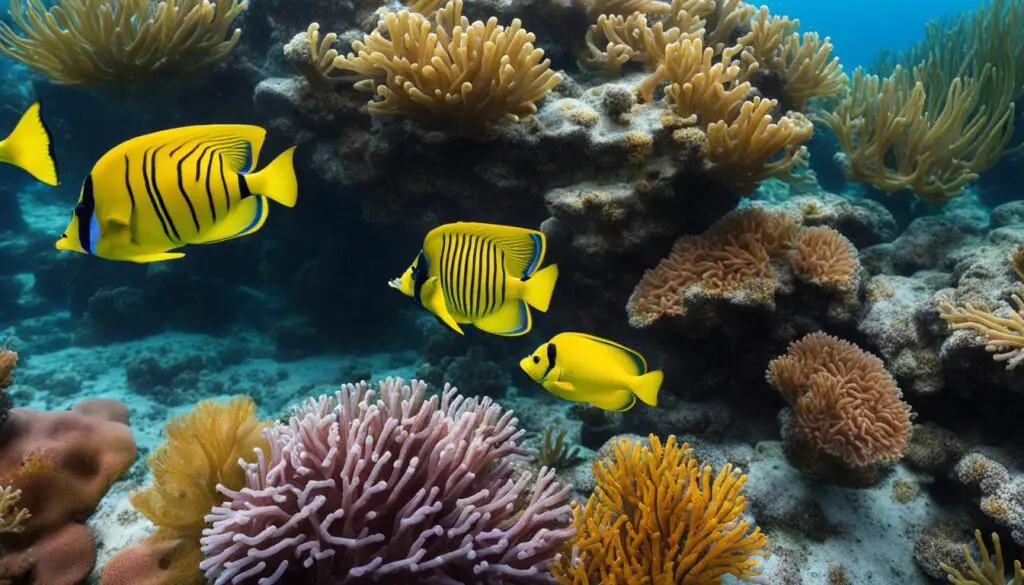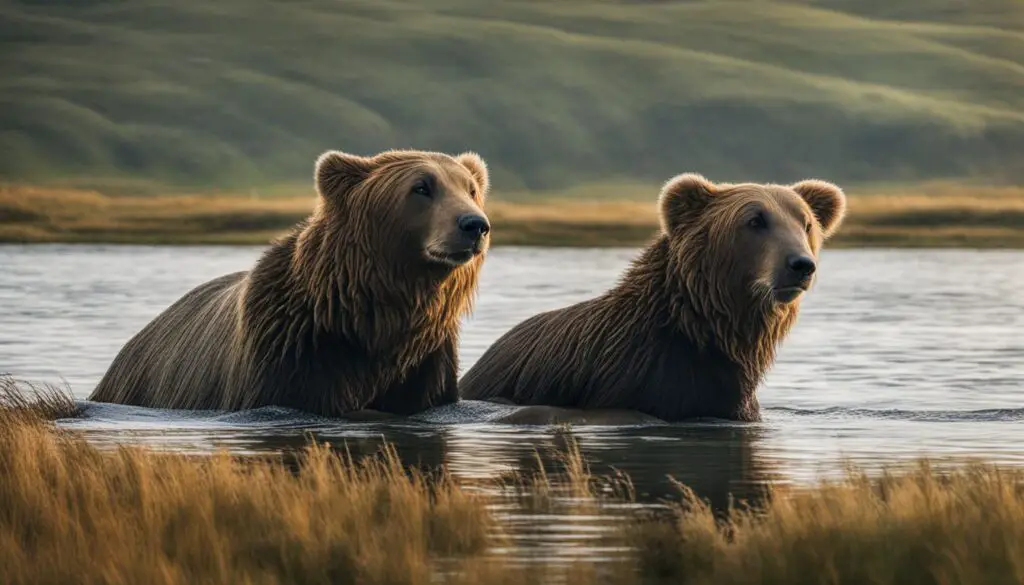Denmark is home to a diverse range of wildlife, making it an intriguing destination for wildlife enthusiasts. From mammals and birds to marine life, Danish wildlife offers a rich and varied experience for nature lovers. The country’s commitment to animal conservation is evident through its efforts to protect endangered species and establish wildlife sanctuaries.
The mammal population of Denmark is notable, with species such as red deer, roe deer, wild boars, and hedgehogs found throughout the country. Danish animal habitats, including forests and moors, provide diverse environments for these mammal populations to thrive.
Denmark also boasts a thriving bird population, with species such as starlings, storks, and various waterfowl. One of the unique natural phenomena in Denmark is the gathering of starlings during migration seasons, known as the “Black Sun,” where hundreds of thousands of starlings create a spectacle that darkens the sky.
The waters surrounding Denmark’s numerous islands are teeming with marine life. The abundance of fish, shellfish, and crustaceans supports a rich ecosystem that includes seals, otters, and occasional whale sightings. Conservation efforts are in place to protect and preserve these marine species and their habitats.
Denmark’s commitment to animal conservation is evident in its efforts to protect endangered species. The Danish Red List identifies species at risk and promotes conservation measures to ensure their survival. Wildlife sanctuaries and protected areas have been established to safeguard these species and their habitats.

Key Takeaways:
- Denmark is home to a diverse range of wildlife, including mammals, birds, and marine life.
- The country has taken conservation efforts seriously, with initiatives to protect endangered species and establish wildlife sanctuaries.
- Denmark’s animal habitats range from forests and moors to marine environments, providing diverse ecosystems for wildlife.
- The “Black Sun” phenomenon, where starlings gather in large numbers during migration seasons, is a unique natural spectacle in Denmark.
- Conservation efforts are in place to protect and preserve marine species, including seals, otters, and whales.
Mammals in Denmark
Denmark is home to a variety of mammal species, making it a fascinating destination for wildlife enthusiasts. The most recent atlas survey of mammals in Denmark recorded 88 unique species, including red deer, roe deer, wild boars, and hedgehogs. These mammals inhabit diverse environments, from forests and moors to the countryside, providing them with a range of habitats to thrive in.
In recent years, Denmark has seen the emergence of three new mammal species – the grey wolf, golden jackal, and Cuvier’s beaked whale. This highlights the ever-evolving nature of Denmark’s wildlife and the importance of conservation efforts to protect these newfound species.
As with any biodiverse region, the conservation status of these mammal species in Denmark varies. Some species are critically endangered or face a high risk of extinction, necessitating focused conservation efforts to ensure their survival. Initiatives such as the Danish Red List play a crucial role in identifying threatened species and promoting conservation measures to safeguard them.
Understanding and preserving Danish animal habitats is vital in ensuring the continued existence of these mammal populations. From the dense forests to the vast moors, each habitat provides a distinct environment for mammals to thrive in. Conservation efforts aim to protect these habitats in their natural state, allowing for the sustained survival of these remarkable mammal species.
Conservation Efforts in Denmark
Denmark recognizes the significance of conserving its diverse mammal species and their habitats. Through initiatives like the Danish Red List, which assesses threatened species based on international conservation criteria, the country works to identify and protect endangered mammals.
“The Danish Red List plays a crucial role in identifying threatened species and promoting conservation measures.”
Efforts are also being made to establish wildlife sanctuaries and protected areas that serve as havens for these species. These protected areas provide a safe environment for mammals to thrive and reproduce. By preserving these habitats, Denmark aims to conserve its rich wildlife heritage for future generations.
The determination to protect and conserve Denmark’s mammal species represents the country’s commitment to safeguarding its biodiversity and ensuring a sustainable future for its wildlife.
| Mammal Species | Conservation Status |
|---|---|
| Red Deer | Least Concern |
| Roe Deer | Least Concern |
| Wild Boar | Least Concern |
| Hedgehog | Least Concern |
| Grey Wolf | Near Threatened |
| Golden Jackal | Data Deficient |
| Cuvier’s Beaked Whale | Data Deficient |
Table: Conservation status of mammal species in Denmark
Birds in Denmark
Denmark boasts a rich diversity of birdlife, with numerous species inhabiting the country. Passerines, wading birds, birds of prey, ducks, and swans are just a few examples of the bird species that can be observed in Denmark’s varied landscapes.
One notable avian phenomenon in Denmark is the gathering of starlings in south-western areas during migration seasons, known as the “Black Sun.” This mesmerizing event attracts hundreds of thousands of starlings, resulting in a breathtaking spectacle as the birds darken the sky with their synchronized movements. It is a visual feast for bird enthusiasts and nature lovers alike.
Storks, once a common sight in Denmark, have become a rarer presence; however, they can still be spotted during the summer months. These elegant birds add charm to the Danish countryside with their distinctive appearance and graceful flight.
Furthermore, Denmark is home to several wildlife sanctuaries that provide protected habitats for birds and other animals. These sanctuaries play a crucial role in conserving Danish wildlife and ensuring the preservation of their natural environments.
Bird species found in Denmark:
- Passerines
- Wading birds
- Birds of prey
- Ducks
- Swans
Experience the beauty and diversity of Danish birdlife in these wildlife sanctuaries and immerse yourself in the wonders of Danish wildlife.
“The flight of birds in Denmark exemplifies the splendid diversity of nature, offering a captivating experience for bird enthusiasts, and reminding us of the importance of preserving their habitats.”
Delve into Denmark’s captivating birdlife, marvel at unique migratory phenomena, and witness the beauty of these feathered creatures in their natural habitats. The rich avian diversity of Denmark is a testament to the country’s commitment to wildlife conservation and offers unforgettable encounters for nature lovers.
Marine Life in Denmark
The waters surrounding Denmark’s more than 400 islands are home to a vibrant and diverse marine ecosystem that supports a wide array of marine life. From fish and shellfish to seals and occasional whale sightings, Danish waters are teeming with fascinating creatures. Notable species found in Denmark include the common seal, ringed seal, and grey seal, which are all important indicators of the health and biodiversity of the marine environment.
The presence of marine mammals such as seals and whales demonstrates the rich and flourishing ecosystem in Danish waters. Furthermore, endangered species like the harp seal and beluga whale have been spotted as vagrants, highlighting the importance of conservation efforts to protect and preserve these unique creatures and their habitats. Denmark’s commitment to safeguarding its marine life ensures the continued existence of these species for future generations to appreciate and admire.

| Species | Common Name | Conservation Status |
|---|---|---|
| Phoca vitulina | Common Seal | Least Concern |
| Pusa hispida | Ringed Seal | Near Threatened |
| Halichoerus grypus | Grey Seal | Least Concern |
| Pagophilus groenlandicus | Harp Seal | Vulnerable |
| Delphinapterus leucas | Beluga Whale | Near Threatened |
Endangered Species and Conservation in Denmark
Denmark is dedicated to preserving its diverse wildlife and protecting endangered species through strong conservation measures. The Danish Red List serves as a crucial resource, identifying species at risk and providing assessments based on international conservation criteria. This enables targeted efforts to safeguard these animals and their habitats.
Among the endangered species in Denmark are the European beaver, the hazel dormouse, and the northern birch mouse. These species face significant threats to their survival, and urgent action is needed to ensure their long-term existence in the Danish ecosystem.
To combat these challenges, Denmark is actively working on establishing wildlife sanctuaries and protected areas. These sanctuaries provide safe havens for endangered species, allowing them to flourish without the risk of habitat destruction or human interference. By designating these areas as sanctuaries, Denmark underscores its commitment to preserving biodiversity and ensuring the survival of native animal populations for future generations.
The following table showcases some of the endangered species in Denmark:
| Endangered Species | Conservation Status |
|---|---|
| European Beaver | Endangered |
| Hazel Dormouse | Endangered |
| Northern Birch Mouse | Vulnerable |

Danish conservation initiatives not only focus on protecting individual species but also aim to create a harmonious balance within the ecosystem. By preserving natural habitats and implementing sustainable practices, Denmark seeks to safeguard the delicate web of life that exists within its borders.
Furthermore, wildlife sanctuaries play a crucial role in promoting conservation awareness and education. These sanctuaries provide opportunities for people to interact with and learn about endangered species, fostering a sense of connection and responsibility for animal welfare.
In conclusion, Denmark’s efforts to protect endangered species and promote animal conservation are commendable. The establishment of wildlife sanctuaries and the identification of endangered species through the Danish Red List are significant steps towards preserving biodiversity and ensuring the long-term survival of Danish wildlife.
Conclusion
Denmark’s diverse animal population, from mammals and birds to marine life, offers a rich and varied wildlife experience. The country’s conservation efforts, including initiatives to protect endangered species and establish wildlife sanctuaries, highlight a commitment to preserving biodiversity and ensuring the survival of Danish wildlife.
With its diverse animal habitats and the unique natural phenomenon of the “Black Sun,” Denmark is a fascinating destination for wildlife enthusiasts and nature lovers alike. Whether exploring the forests and moors to spot mammals like red deer and wild boars, observing the abundant bird species throughout the country, or diving into the waters to encounter seals and otters, Denmark provides an immersive wildlife experience.
Visitors can also appreciate Denmark’s commitment to conservation, with the establishment of wildlife sanctuaries and protected areas. These efforts aim to safeguard endangered species and their habitats, contributing to the preservation of biodiversity and the long-term survival of Danish wildlife.
Whether you are captivated by the majestic sight of starlings during the “Black Sun” phenomenon or drawn to the thrill of spotting rare birds and marine mammals, Denmark offers a captivating and enriching wildlife adventure.
FAQ
What kind of animal species can be found in Denmark?
Denmark is home to a diverse range of animal species, including mammals such as red deer, roe deer, wild boars, and hedgehogs. Birds such as starlings, storks, and various waterfowl can also be found. Additionally, the surrounding waters are home to fish, shellfish, seals, otters, and occasional whale sightings.
Are there any endangered species in Denmark?
Yes, there are endangered and vulnerable species in Denmark. The European beaver, hazel dormouse, and northern birch mouse are among the endangered species identified in Denmark. Conservation efforts are being made to protect and preserve these species and their habitats.
Are there any wildlife sanctuaries in Denmark?
Yes, Denmark has established wildlife sanctuaries and protected areas to safeguard animal species and their habitats. These sanctuaries provide protected environments for birds, mammals, and other wildlife.
What is the "Black Sun" phenomenon in Denmark?
The “Black Sun” is a natural phenomenon that occurs in south-western Denmark during migration seasons. Hundreds of thousands of starlings congregate and create a spectacle where the birds darken the sky. It is a fascinating phenomenon for birdwatching enthusiasts.
How is Denmark working to protect endangered species?
Denmark is committed to protecting endangered species and promoting animal conservation. The Danish Red List identifies threatened species and provides assessments based on international conservation criteria. Efforts are being made to establish wildlife sanctuaries and protected areas to safeguard these species and their habitats.
